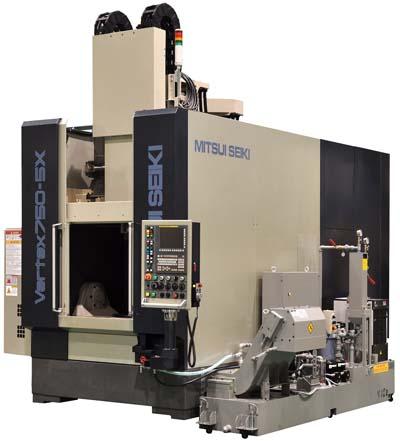
Mitsui Seiki's "Vertex" line of Vertical Machining Centers got bigger with the addition of a new, larger machine, the Vertex 750-5X. In response to requests from existing customers and the precision component marketplace, the new Vertex 750 offers the following benefits for high performance machining: work envelope of X-axis 750mm, Y-axis 800mm, Z-axis 700mm; weight capacity 500Kg (1100 lbs); small footprint 2200mm X 3740mm (87" X 147"); hand-scraped casting for ultrahigh geometrical accuracy; rapid traverse rate of 48m/min (1890 ipm) feed rate of 20m/min (787 ipm); integrated trunnion offers fourth and fifth axes with maximum work size of 950mm dia. and 650mm high; 15,000 or 25,000 high stiffness spindles with 40 taper or HSK63 tool types; ergonomic access for loading and operation; and Fanuc 31i CNC with the latest Fanuc features for multi-axis contouring. According to Mitsui Seiki, the accuracy of the Vertex line rivals its best jig boring equipment and offers the machining performance of its larger machining centers. Typical applications for this model include aerospace components, molds and dies, and other precision components. As with all of Mitsui Seiki's machine tools, the Vertex 750-5X is available with a wide variety of options and features to permit versatile machining opportunities.
Contact Details
Related Glossary Terms
- boring
boring
Enlarging a hole that already has been drilled or cored. Generally, it is an operation of truing the previously drilled hole with a single-point, lathe-type tool. Boring is essentially internal turning, in that usually a single-point cutting tool forms the internal shape. Some tools are available with two cutting edges to balance cutting forces.
- centers
centers
Cone-shaped pins that support a workpiece by one or two ends during machining. The centers fit into holes drilled in the workpiece ends. Centers that turn with the workpiece are called “live” centers; those that do not are called “dead” centers.
- computer numerical control ( CNC)
computer numerical control ( CNC)
Microprocessor-based controller dedicated to a machine tool that permits the creation or modification of parts. Programmed numerical control activates the machine’s servos and spindle drives and controls the various machining operations. See DNC, direct numerical control; NC, numerical control.
- feed
feed
Rate of change of position of the tool as a whole, relative to the workpiece while cutting.
- jig
jig
Tooling usually considered to be a stationary apparatus. A jig assists in the assembly or manufacture of a part or device. It holds the workpiece while guiding the cutting tool with a bushing. A jig used in subassembly or final assembly might provide assembly aids such as alignments and adjustments. See fixture.
- jig boring
jig boring
High-precision machining (a sophisticated form of milling) that originally pertained to jig and fixture manufacturing. Basic jig-boring processes include centering, drilling, reaming, through and step boring, counterboring and contouring.
- rapid traverse
rapid traverse
Movement on a CNC mill or lathe that is from point to point at full speed but, usually, without linear interpolation.
- stiffness
stiffness
1. Ability of a material or part to resist elastic deflection. 2. The rate of stress with respect to strain; the greater the stress required to produce a given strain, the stiffer the material is said to be. See dynamic stiffness; static stiffness.
- work envelope
work envelope
Cube, sphere, cylinder or other physical space within which the cutting tool is capable of reaching.
